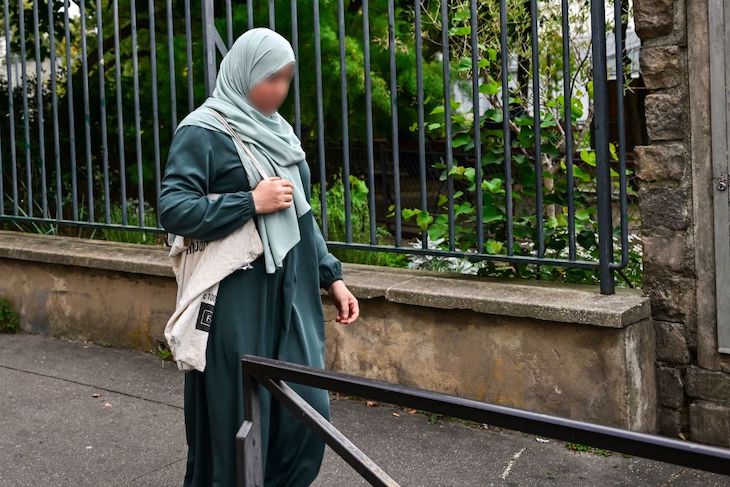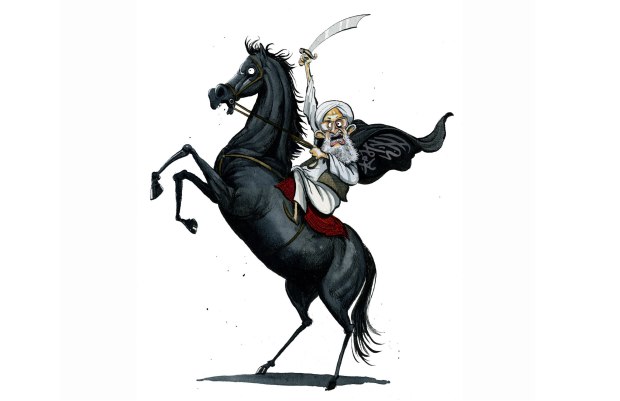The intellectual infirmity that has laid low much of Europe’s left this century had been painfully exposed this week in France. On Monday, the country’s new minister of education, Gabriel Attal, announced that when pupils return to the classroom next week none will be permitted to wear the abaya, a conservative form of Islamic dress that is worn to preserve one’s modesty. Justifying the interdiction, Attal said the abaya contravened France’s strict rules on the wearing of religious symbols to school.
‘Secularism means the freedom to emancipate oneself through school,’ Attal explained. ‘You enter a classroom, you must not be able to identify the students’ religion by looking at them.’
France first took a stand against the growth of Islamic conservatism in 2004, when it banned the Islamic headscarf (along with other religions’ accoutrements), and it has been forced to act after thousands of pupils began arriving to school in the long and baggy abaya.
My wife, a teacher in a state school in a deprived suburb of northern Paris, tells me that until the start of this year she had never seen an abaya in her classroom. Within weeks they became commonplace. In some cases they were worn by body-conscious girls, a way of concealing anxieties about their weight.
But religion is the main reason the abaya has taken off. Its popularity spread on TikTok, as part of a campaign aimed at challenging the Republic’s secularism. Jean-Éric Schoettl, secretary general of France’s constitutional council from 1997 to 2007, wrote in Tuesday’s Le Figaro: ‘To dismiss the abaya as a mere ‘cultural’ fad, or to put it down to an adolescent crisis, is to deny that it is an expression of adherence to a political Islam that pursues a hegemonic goal.’
My wife, a teacher in a state school in a deprived suburb of northern Paris, says that until the start of this year she had never seen an abaya in her classroom
Those radicals who are said to be behind the campaign also rely on the self-loathing of elements of the French left; ironically, it was the left that was the driving force behind the passing of the ‘laïcité’ law in 1905, which separated the church and the state and enshrined the Republic’s secularism. More than a century later, the roles are reversed and the French right – who were broadly opposed to the 1905 law because Catholicism was the primary target – uphold the country’s secularism, while many on the left attack it, in the name of Islamism.
Although a handful of prominent figures on the left supported the government’s decision to ban the abaya – notably Fabien Roussel, the leader of the French Communists, and Jérôme Guedj, a Socialist MP – most were outraged.
Clémentine Autain, a member of Jean-Luc Melenchon’s La France Insoumise party, described the move as the ‘policing of clothing’. One of her party colleagues, Manuel Bompard, said it was ‘dangerous’ and ‘cruel’; he has also floated the idea of challenging the interdiction in court.
Twelve months ago, Autain supported the brave young women of Iran who cast off their headscarves in protest after one of their peers was beaten to death by police for incorrectly wearing hers. Autain should be supportive of the government ban. For the endgame of every Islamic conservative, be they in Tehran, Toulouse or Tottenham, is to have women hidden away under an abaya or a hijab. In recent decades they have relied on Europe’s Useful Idiots to endorse this strategy, so the French government is to be applauded in showing that the intolerant will not be tolerated. The decision to ban the abaya in schools is not, contrary to what Autain says, the ‘policing of clothing’.
Autain and her ilk are out of step with public opinion on the issue of Islamic dress. In a survey this summer, only 23 per cent of people expressed support for the wearing of such garments in schools. Even among left-wing voters, there was widespread opposition to the abaya, with 60 per cent of La France Insoumise supporters expressing their disapproval and three quarters of Socialists believing it should be banned.
This isn’t the only issue on which the French left and its voters don’t see eye to eye; it’s rare to find any left-wing politician who believes there are too many illegal immigrants in France; yet when the question was put to the public earlier this year the results were revealing. Not surprisingly, right-wing voters believe there is an immigration crisis in France (97 per cent in the case of Marine Le Pen’s National Rally), but even among voters who identified as Socialist or Green, more than half expressed their belief that illegal immigrants were too numerous.
Recently, Europe has moved to the right, a process that has accelerated in the last year with Italy, Finland and Greece voting in governments of that persuasion. Additionally, Le Pen is now a major force in French politics and the AfD is on the rise in Germany. A senior EU diplomat attributed this phenomenon to the ‘Meloni effect’, referring to Italy’s prime minister. The diplomat added: ‘On migration, on climate, there has been a move towards the right, undoubtedly.’
But this ideological transition has been facilitated to a large degree by the feebleness of the left in confronting the challenge of mass immigration and the rise of an aggressive and assertive political Islam. The right is not so reluctant and, as a result, they have reaped their reward at the ballot box.
The exception is in Denmark, where the Social Democrats are in power because they were honest enough to admit the country had an immigration crisis and they were then bold enough to do something about it.
The French left will never taste power again until they can summon up similar courage.
Got something to add? Join the discussion and comment below.
Get 10 issues for just $10
Subscribe to The Spectator Australia today for the next 10 magazine issues, plus full online access, for just $10.





















Comments
Don't miss out
Join the conversation with other Spectator Australia readers. Subscribe to leave a comment.
SUBSCRIBEAlready a subscriber? Log in